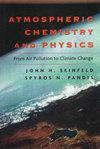Global source apportionment of aerosols into major emission regions and sectors over 1850–2017
IF 5.2
1区 地球科学
Q1 ENVIRONMENTAL SCIENCES
引用次数: 0
Abstract
Abstract. Anthropogenic emissions of aerosols and precursor gases have been changing significantly in the past few decades across the world. In this study, an explicit aerosol source tagging system (EAST) is merged into the Energy Exascale Earth System Model version 1 (E3SMv1) to quantify the variations in anthropogenic aerosol concentrations, source contributions, and their subsequent radiative impact in four major emission regions on the globe during 1850–1980, 1980–2010 and 2010–2017. In North America and Europe, changes in anthropogenic PM2.5 were mainly caused by changes in emissions from local energy and industrial sectors. The local industrial sector caused the most increase in PM2.5 in East Asia during1980–2010 and decrease during 2010–2017. In South Asia, the increase in energy-related emissions dominated the rise of PM2.5 levels during 1980–2017. During 1850–1980, the increases in emissions from North America contributed to the increase in European PM2.5 burden by 1.7 mg m-2 and the sources from the Europe were also responsible for the PM2.5 burden increase in East Asia and South Asia by about 1.0 mg m-2. During 1980–2010, East Asia contributed to an increase of 0.4–0.6 mg m-2 in PM2.5 burden in North America and Europe, while South Asian contributed about 0.3 mg m-2. During 2010–2017, the contributions from East Asia to the PM2.5 burdens in the North America, Europe and South Asia declined by 0.3–0.6 mg m-2 due to Clean Air actions in China, while the contributions from South Asia still increased due to the continuous increase in emissions in South Asia. The historical changes in aerosols had an impact on effective radiative forcing through aerosol-radiation interactions (ERFari). During 1980–2010, a decline in North American aerosols resulted in a positive ERFari change (warming effect) in Europe and a decline of aerosols in Europe caused a warming effect in Russia and northern China. The changes in ERFari from the increase and decrease of aerosols in China during 1980–2010 and 2010–2017, respectively, are comparable in magnitude. The continuous aerosol increases in South Asia from 1980 to 2017 resulted in negative ERFari (cooling) changes in South Asia, Southeast Asia, and southern China.1850-2017 年按主要排放区域和部门划分的全球气溶胶源分配情况
摘要过去几十年来,全球人为气溶胶和前体气体排放发生了显著变化。在这项研究中,将显式气溶胶源标记系统(EAST)并入能源超大规模地球系统模式第一版(ESMv1),以量化1850-1980年、1980-2010年和2010-2017年期间全球四个主要排放区域人为气溶胶浓度、源贡献及其后续辐射影响的变化。在北美和欧洲,人为 PM2.5 的变化主要是由当地能源和工业部门的排放变化引起的。在东亚,当地工业部门在1980-2010年期间造成的PM2.5增加最多,而在2010-2017年期间则有所减少。在南亚,1980-2017 年期间,能源相关排放的增加主导了 PM2.5 水平的上升。1850-1980 年间,北美排放量的增加导致欧洲 PM2.5 负荷增加了 1.7 毫克/立方米,欧洲的排放源也导致东亚和南亚的 PM2.5 负荷增加了约 1.0 毫克/立方米。1980-2010年期间,东亚导致北美和欧洲的PM2.5负荷增加了0.4-0.6毫克毫升-2,而南亚的贡献约为0.3毫克毫升-2。2010-2017 年期间,由于中国的清洁空气行动,东亚对北美、欧洲和南亚 PM2.5 负担的贡献下降了 0.3-0.6 毫克/立方米,而由于南亚排放量的持续增长,南亚的贡献仍在增加。气溶胶的历史变化通过气溶胶-辐射相互作用(ERFari)对有效辐射强迫产生了影响。在 1980-2010 年期间,北美气溶胶的减少导致了欧洲 ERFari 的正变化(变暖效应),而欧洲气溶胶的减少则导致了俄罗斯和中国北方的变暖效应。1980-2010年和2010-2017年期间,中国气溶胶的增加和减少分别导致的ERFari变化幅度相当。1980-2017年南亚气溶胶的持续增加导致南亚、东南亚和中国南部的ERFari(降温)出现负变化。
本文章由计算机程序翻译,如有差异,请以英文原文为准。
求助全文
约1分钟内获得全文
求助全文
来源期刊

Atmospheric Chemistry and Physics
地学-气象与大气科学
CiteScore
10.70
自引率
20.60%
发文量
702
审稿时长
6 months
期刊介绍:
Atmospheric Chemistry and Physics (ACP) is a not-for-profit international scientific journal dedicated to the publication and public discussion of high-quality studies investigating the Earth''s atmosphere and the underlying chemical and physical processes. It covers the altitude range from the land and ocean surface up to the turbopause, including the troposphere, stratosphere, and mesosphere.
The main subject areas comprise atmospheric modelling, field measurements, remote sensing, and laboratory studies of gases, aerosols, clouds and precipitation, isotopes, radiation, dynamics, biosphere interactions, and hydrosphere interactions. The journal scope is focused on studies with general implications for atmospheric science rather than investigations that are primarily of local or technical interest.
 求助内容:
求助内容: 应助结果提醒方式:
应助结果提醒方式:


